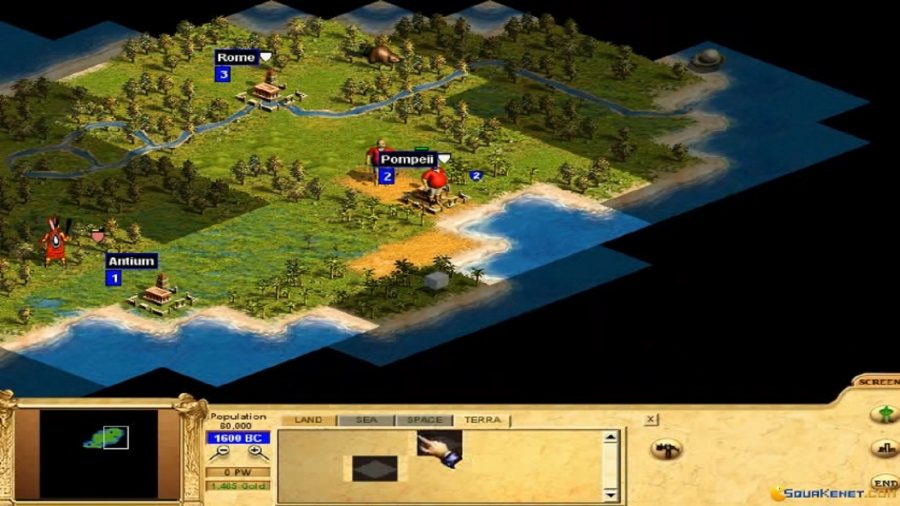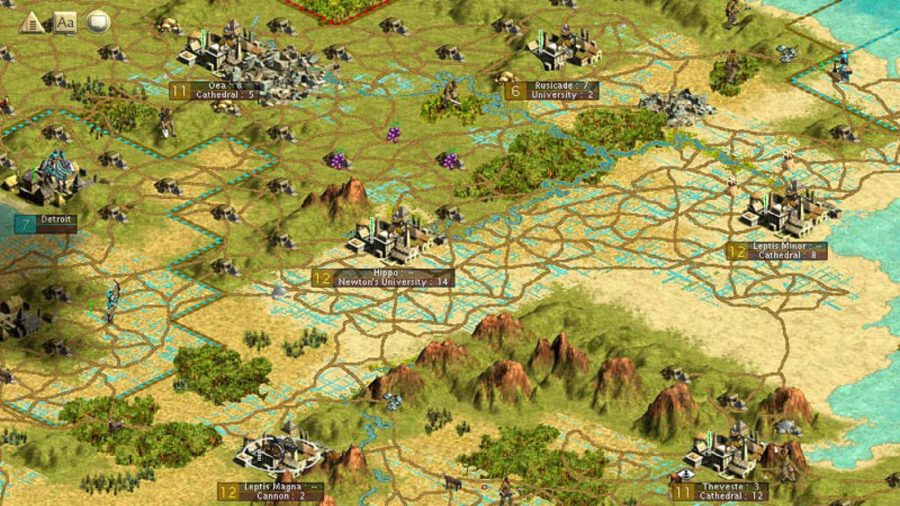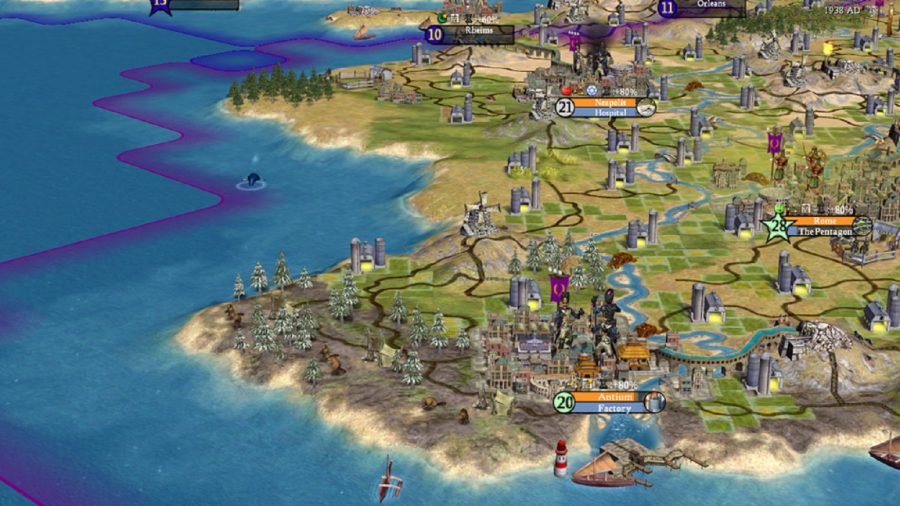So, you want to know what the best Civilization game is? Sid Meier’s classic line of 4X strategy games is quite long in the tooth now, and that’s not even counting all of the spin-offs. With a series this old, and a fan base so engaged, players can’t help but ask the ultimate question: which Civ game is best?
Luckily – considering we’re all sitting around waiting for Civilization 7 at the moment – we’ve not got anything better to do, so we’ve put together a guide to answer this very question. As you’re about to see, before subsequently spitting your coffee over your screen like a sitcom character, we’ve included the Call to Power games in this list. We’ve also omitted Beyond Earth and Alpha Centauri, even though the former carries the Civ nomenclature and the latter carries the Meier name.
Why? Because Civ games, to us, are about guiding a people from prehistory to the future, journeying through recognisable periods of human history and doing it on Earth. While CtP deviates from that formula slightly, it’s still very recognisable as the classic Civ experience. Beyond Earth and Alpha Centauri? Well, their names say it all. Which entries propelled Civ to glory, and which are best left in the past? Join us as we chart the series from its ancient era to the modern day, and rank each of the Civilization games from worst to best.
The Best civilization Games
These are the best Civilization games:
- Civilization: Call to Power
- Civilization II
- Civilization
- Call to Power 2
- Civilization III
- Civilization V
- Civilization VI
- Civilzation IV
No we will not be taking questions at this time
Civilization: Call to Power
Purists will scoff at the inclusion of Activision’s ambitious yet shambolic stab at the great empire-builder, but it marked a blip in the history of the series that’s kind of fascinating.
Related: The best 4X games on PC
Call to Power arose out of legal tussles between Activision and Microprose over the board game origins of the ‘Civilization’ trademark. Made without Sid Meier, Jeff Briggs, and co at the helm, it was Activision’s first stab at the Civ franchise, which perhaps explains why it seemingly crammed every idea into it that a single game could possibly hold.
Featuring outlandish ideas like space warfare and underwater cities, as well as a whole wealth of sneaky units like lawyers, slavers, televangelists with televisions for heads and, errr, steampunky blimps that beamed advertising onto enemy Civs, Call to Power was nothing if not ambitious. It was marred by a poor interface and bad implementation however, with all the extra content making the game feel bloated and unfocused, with the late-game feeling like a hellish rabble of conflicting ideas that, frankly, was a bit grim to be a part of. Let’s just call it ‘Franken-civ’ and move on…
Civilization II
Civ II probably deserves an apology for being put in line right next to the black sheep of the family, because it really is a far superior game. It took the series out of a top-down view into a more immersive isometric perspective, expanded the number of techs and playable civs, and deepened war and diplomacy.
Related: The best turn-based strategy games on PC
Yet when I upgraded from Civ 1 to Civ II, I remember that for all its added polish and depth, it felt somehow colder than the original; little things like the fact that leader screens were just generic portraits, the static city view, and those awful video clips of advisors dressed up like they were going to a Roman-themed uni party.
Not that those niggles stopped me from pouring half a decade of my life into it, and remembering its sweetly 90s soundtrack to this day. Just like every other Civ game – it ranks among the greatest games of its time. We recently reflected on it when the game turned 25 years old.
Civilization
Where it all began. It’s fitting that one of my enduring memories of Civ is that pixellated cutscene of a young Earth smouldering into existence, because that’s precisely the role this game played for the series – setting the scene for generations to come.
With its blocky bird’s-eye view, only seven leaders and a comparatively small tech tree, of course the original is also technically the crudest, but it had some flourishes that gave it a big personality.
Meeting each leader was a treat, and your negotiations with them would be dramatised by their contorting, shifting faces as you inevitably pissed them off for calling them an ostrich or not handing over your techs to them. The city view – fully animated by gorgeous sprites – remains the best in the series, and the different looks of the advisers when you changed government were a great touch. It had a charm that was unmatched until much later in the series.
Call to Power 2
If the purists were scoffing before, they’ll be choking on their self-righteous lentils that Call to Power 2 – which doesn’t even have the word ‘Civilization’ in the title – makes it onto this list among the Sid Meier thoroughbreds.
Related: The best Total War games
For all intents and purposes it is a Civ game, and Activision’s second and final stab at the Civ formula was a big improvement on its bloated predecessor. Yes, there are still slavers and those blasted lawyers being a nuisance, but the improved interface, better diplomacy, and ability to automate units make it more enjoyable. It even introduced a couple of innovations like cultural borders and ‘armies’, both of which were taken on in subsequent games (the latter appears in Civ VI as ‘combined arms’).
Call to Power 2 cut out its predecessor’s underwater cities and space colonisation, but still has its share of interesting features – like global warming and futuristic army units – that spiced up the gameplay. The source code for the game was released in 2003, and if you do want to give it a crack you can buy it at GOG. It’s best played with the CtP2 Apolyton patch, which fixes many of the bugs and improves AI.
Civilization III
The oldest Civilization game that manages to feel timeless, thanks to a spit-and-polished pixel aesthetic, lovely animations, and deep systems that remain a central part of the series to this day. Civ III introduced Civilization traits, endowing each civ with more individuality, and encouraging different strategies depending on which one you chose. It built on the idea of national borders established in CtP 2, and was also (regrettably) the last Civ game to have a city view.
Civ III had a few maverick features too. You could monopolise strategic resources and luxuries then sell them on for a premium, had to deal with corruption in distant cities, and even faced the occasional volcanic explosion. Best of all, leaders would wear clothing befitting of their era; who doesn’twant to see Abe Lincoln in a fur hat and jerkin in 1000BC?
Civilization V
In a huge overhaul, Firaxis ‘de-stacked’ units and changed the map from a square grid to a hex grid for Civ V. This helped make maps feel more geographically natural than ever before, and wars far more satisfying, as good tactics and positioning could often defeat a far bigger force. City States were a welcome new feature too.
More like this: The best Civ 5 mods
Civ V was far from perfect upon release. The AI was bonkers (not in the ‘fun-at-a-party’ way), vassalage from Civ IV was dropped, and espionage felt over-simplified. With the expansion packs Civ V truly came into its own, though the fact that these were required to make the it shine meant that the game felt like it went backwards before truly moving forwards.
Check out the Civ V Community Patch Project as well if you want an interesting rejig of the rules, better AI, and the reinstatement of Civ IV features like vassal states and deeper espionage. We’ve also got a guide to the best Civ 5 civs.
Civilization VI
Where Civ V pared back on many of the great features introduced in its predecessor, the latest entry retains just about all of them. Religion, tourism, espionage and City States are all here, and have been rejigged to offer the deepest Civ experience yet, which is deceived by the bold, colourful visual style that looks incredible in motion.
The big decision to de-stack cities, spreading them across several tiles with separate zones for different building types, was an inspired one, forcing you to be more tactical about city placement. The option to merge different unit types and form armies, meanwhile, gets rid of the unit clutter that oft plagued Civ V.
From the scrawled maps that have replaced the dreaded Fog of War, to the Wonders that now stand proud and massive on their own tiles, to the art style of the Civ 6 leaders, this is definietly a high note for the modern era of Civilization games. The Civ 6 DLC library, including the wonderful stuff to come out of the New Frontier Pass, further elevate this game. Despite all this, however, the King (or Deity?) remains unchallenged. There are some amazing Civ 6 mods to check out too.
Civilization IV
Remember the charm I prattled on about while discussing the original Civ? Well, this is where it made a triumphant return – with full 3D graphics. From that sweeping, lovely menu music (Baba Yetu), to Leonard Nimoy sagely giving you inspirational quotes each time you discovered a technology, to the fact that in the late-game you could seamlessly zoom out into space and see the whole world, Civ IV was a real charmer.
It wasn’t just superficial, either. Religion as a tool of control made its debut, and with the expansions we got fantastic features like vassal states and espionage. I’ll never forget my successful death-or-glory mission to sabotage Mansa Musa’s spaceship production which let me steal the Space Race victory at the eleventh hour.
For all its charms, Civ IV was still flawed. War was an unstrategic slog consisting of the infamous ‘stacks of doom’, the late-game dragged on, and religion was never as effective as it could’ve been. Even though going back to it now is surprisingly tough after playing the complete versions of Civ V and Civ VI, the depth and presentation of Civ IV, and its role in progressing the series, wins it the top spot.
Related: The best games like Civilization
So there we have it. The definitive Civ rankings so you don’t need to do them yourself or get enraged about how wrong we are.
Additional contributions by Joe Robinson.








